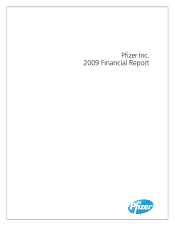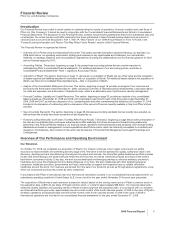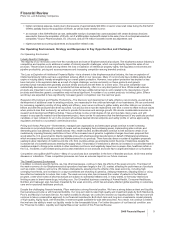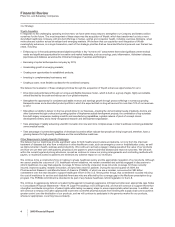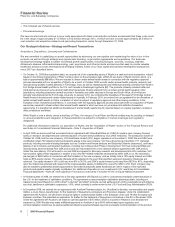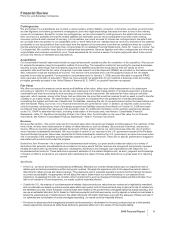Pfizer 2009 Annual Report Download - page 7
Download and view the complete annual report
Please find page 7 of the 2009 Pfizer annual report below. You can navigate through the pages in the report by either clicking on the pages listed below, or by using the keyword search tool below to find specific information within the annual report.
Financial Review
Pfizer Inc. and Subsidiary Companies
We have evolved our Biopharmaceutical operations into smaller, more focused units to anticipate and respond more quickly to our
customers’ and patients’ changing needs. With the formation of the Primary Care, Specialty Care, Established Products, Oncology
and Emerging Markets units, we believe we can better manage our products’ growth and development from proof-of-concept
throughout their entire time on the market; bring innovation to our “go to market” promotional and commercial strategies; develop
ways to further enhance the value of mature products, including those close to losing their exclusivity; expand our already
substantial presence in emerging markets; and create product-line extensions where feasible.
We continue to develop and deliver innovative medicines that will benefit patients around the world. We continue to make the
investments that we believe are necessary to serve patients’ needs and to generate long-term growth. For example:
•We have reorganized our R&D organization, which now consists of two distinct groups; the PharmaTherapeutics Research &
Development group, which focuses on the discovery of small molecules and related modalities and; the BioTherapeutics Research &
Development group, which focuses on large-molecule research, including vaccines. Together, we believe these groups will help
maximize new opportunities in biopharmaceutical research.
•We announced that we would reduce our R&D site footprint by 35% through the closing of six R&D sites and consolidation of four
others. Once these actions are complete, we expect to have an R&D biomedical presence in the U.S., Europe, Canada and China with
five major sites and nine specialized units.
•We have prioritized our portfolio with a focus on the “invest to win” areas, as well as vaccines and biologics. Approximately 70% of our
research projects and 75% of our late-stage portfolio are focused on these areas.
•We continue to conduct research on a significant scale in an effort to discover and develop new medicines. As of January 27, 2010,
reflecting the acquisition of Wyeth, our R&D pipeline includes about 500 projects in development ranging from discovery through
registration, of which 133 programs are from Phase 1 through registration. The projects within our “invest to win” areas include 30
compounds for various oncology indications, 10 compounds for Alzheimer’s disease, eight compounds for pain, 11 compounds for
inflammation, six vaccines and 27 biologics.
•We met our legacy Pfizer goals made in March 2008 to initiate 10 to 12 Phase 3 starts between March 2008 and March 2009, to initiate
15 Phase 3 starts in the 2008 to 2009 period and to have 24 to 28 new molecular entities and new indications in the Phase 3 pipeline
by the end of 2009. With the addition of Wyeth, the new combined company pipeline has a total of 34 new molecular entities and new
indications in Phase 3. For further information about our pending new drug applications (NDA) and supplemental filings, see the
“Revenues—Product Developments” section of this Financial Review.
•While a significant portion of R&D is done internally, we continue to seek to expand our pipeline by entering into agreements with other
companies to develop, license or acquire promising compounds, technologies or capabilities. Collaboration, alliance and license
agreements and acquisitions allow us to capitalize on these compounds to expand our pipeline of potential future products.
Our Cost-Reduction Initiatives
Since the acquisition of Wyeth, we are focused on achieving an appropriate cost structure for the combined company, which
includes capturing synergies company-wide. We anticipate the cost-reduction initiatives that were announced on January 26, 2009,
to achieve a reduction in adjusted total costs of approximately $3 billion, at 2008 average foreign exchange rates, compared with our
2008 adjusted total costs of $28.6 billion (for an understanding of Adjusted income, see the “Adjusted Income” section of this
Financial Review). We plan to reinvest approximately $1 billion of these savings in the business, resulting in an expected $2 billion
net cost reduction. Additionally, as a result of the Wyeth acquisition, Pfizer expects to generate synergies of approximately $4 billion
by the end of 2012, which is expected to result in $2 billion to $3 billion in net cost savings after reinvestment in the business, by the
end of 2012. In the aggregate, as we combine these two initiatives into one comprehensive program, we expect to generate gross
cost reductions of approximately $7 billion, resulting in net cost reductions of approximately $4 billion to $5 billion, by the end of
2012, at 2008 average foreign exchange rates, in comparison with the 2008 pro-forma combined adjusted total costs of Pfizer and
the legacy Wyeth operations.
These targeted savings are expected to be achieved through the following actions:
•The closing of duplicative facilities and other site rationalization actions company-wide, including research and development facilities,
manufacturing plants, sales offices and other corporate facilities.
OResearch and Development Sites––In combining the R&D organizations of Pfizer and Wyeth, we have identified changes that we
expect will increase productivity of the R&D organization and reduce costs. As of the closing of the acquisition of Wyeth, we operated
in 20 R&D sites. In the fourth quarter of 2009, we announced that we would close six sites, and once these actions are completed,
R&D will be conducted at five major sites and nine specialized units around the world.
OManufacturing Sites—Our global manufacturing network is a global strategic supply network consisting of our internal network of
plants together with strategic external manufacturers and including purchasing, packaging and distribution. As of December 31,
2009, operational manufacturing sites totaled 81. We will continue to rationalize our internal network of plants around the world
resulting in a more focused, streamlined and competitive manufacturing operation.
•Workforce reductions across all areas of our business and other organizational changes.
OWe have identified areas for a reduction in workforce across all of our businesses. As of the closing of the Wyeth acquisition, the
combined workforce was approximately 120,700 and, as of December 31, 2009, the workforce had decreased to 116,500.
2009 Financial Report 5

